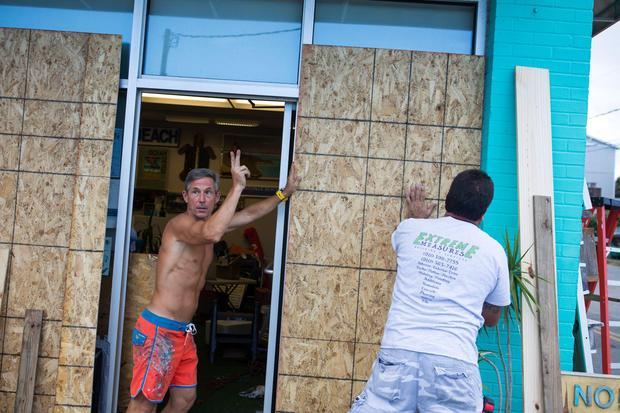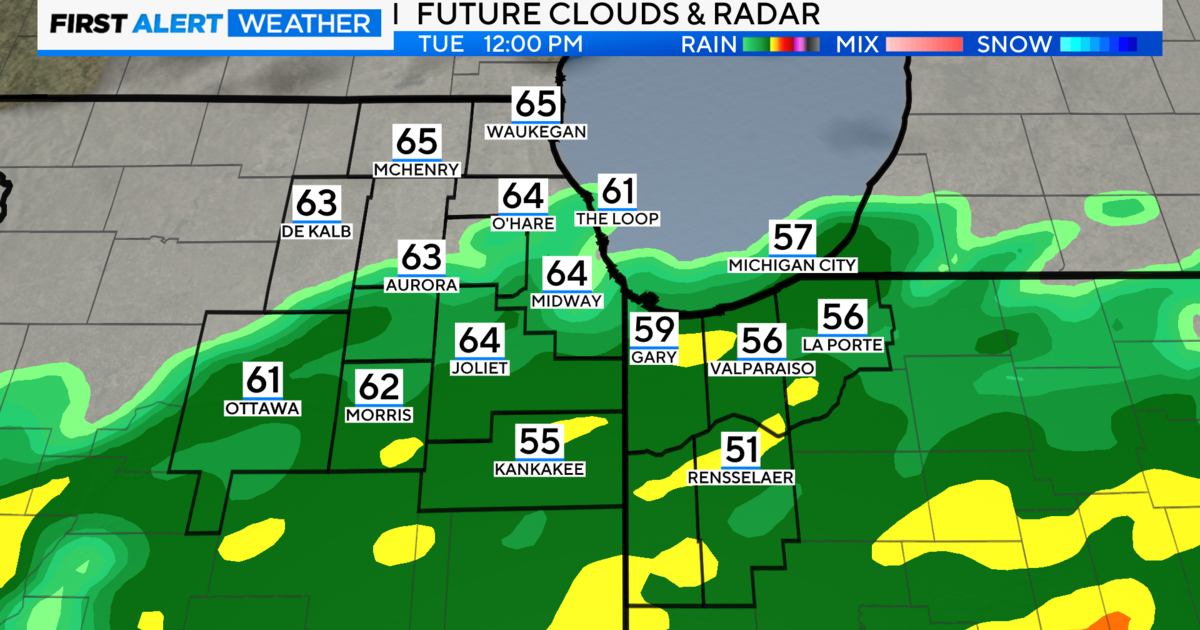'Monster' Hurricane Could Punish A Longer Stretch Of Coastline Than Previously Feared
(CBS) -- Hurricane Florence fast facts:
- Florence is a potentially catastrophic Category 4 storm approaching the U.S. East Coast
- At 11 a.m. Wednesday, the storm was centered 485 miles southeast of Wilmington, North Carolina, moving at 15 mph
- Storm's center will "approach the coast of North Carolina or South Carolina in the hurricane warning area on Thursday and Friday and move slowly near the coastline through Saturday," National Hurricane Center says
- The track has shifted somewhat south and west, throwing Georgia into peril as Florence moves inland
- About 1.7 million people in North and South Carolina and Virginia were under warnings to evacuate the coast as of Tuesday; hurricane watches and warnings extended across an area with about 5.4 million residents
WILMINGTON, N.C. -- Communities along the Carolina coast prepared for the onslaught of Hurricane Florence as forecasters Wednesday warned that the monstrous storm could hesitate just offshore for days -- punishing a longer stretch of coastline than previously feared -- before pushing its way inland.
The National Hurricane Center's projected track had Florence hovering off the southern North Carolina coast from Thursday night until landfall Saturday morning or so, about a day later than previously expected. The track also shifted somewhat south and west, throwing Georgia into peril as Florence moves inland.
On Wednesday afternoon, Georgia's governor declared a state of emergency.
"In light of the storm's forecasted southward track after making landfall, I encourage Georgians to be prepared for the inland effects of the storm as well as the ensuing storm surge in coastal areas," said Gov. Nathan Deal.
At 11 a.m., the storm was centered 485 miles -- 785 kilometers -- southeast of Wilmington, North Carolina, moving at 15 mph.
It is a potentially catastrophic Category 4 storm with 130 mph maximum sustained winds. The National Hurricane Center said life-threatening storm surge and rainfall is expected across parts of North and South Carolina.
"On the forecast track, the center of Florence will move over the southwestern Atlantic Ocean between Bermuda and the Bahamas today, and approach the coast of North Carolina or South Carolina in the hurricane warning area on Thursday and Friday and move slowly near the coastline through Saturday," the center said late Wednesday morning.
- North Carolina's Outer Banks empty as Florence closes in
- Hurricane Florence could be costliest storm ever to hit the U.S.
The overall trend is "exceptionally bad news," said University of Miami hurricane researcher Brian McNoldy, since it "smears a landfall out over hundreds of miles of coastline, most notably the storm surge."
Some strengthening is forecast through Wednesday night, drawing energy from the warm water. Its winds could approach Category 5 strength, which means winds of 157 mph or higher.
"This is not going to be a glancing blow," Jeff Byard, an administrator with the Federal Emergency Management Agency, warned. "This is going to be a Mike Tyson punch to the Carolina coast."
With South Carolina's beach towns more in the bull's-eye, Ohio vacationers Chris and Nicole Roland were trying to time their evacuation from North Myrtle Beach to get the mainland.
"It's been really nice," Nicole Roland said. "Also, a little creepy. You feel like you should have already left."
As of Tuesday, about 1.7 million people in North and South Carolina and Virginia were under warnings to evacuate the coast, and hurricane watches and warnings extended across an area with about 5.4 million residents.
Some said they planned to stay put, but many weren't taking any chances.
Steady streams of vehicles full of people and belongings flowed inland Tuesday as North Carolina Gov. Roy Cooper tried to convince everyone on North Carolina's coast to flee.
"The waves and the wind this storm may bring is nothing like you've ever seen. Even if you've ridden out storms before, this one is different. Don't bet your life on riding out a monster," he said.
President Donald Trump is urging those in the path of the storm to act now to "get out of its way."
"Don't play games with it. It's a big one," he told residents.
In a videotaped message from the Rose Garden, he said the federal government and first responders stand ready to assist, but even so, "bad things can happen when you're talking about a storm this size."
Mr. Trump has declared states of emergency for North and South Carolina and Virginia, opening the way for federal aid. All three states ordered mass evacuations along the coast.
Getting out of harm's way has proved difficult since airlines were canceling flights and motorists had a hard time finding fuel.
Flight-tracking service FlightAware said Wednesday that it was starting to see airlines file cancellations for airports in Florence's path.
As of early afternoon, total cancellations within, into, or out of the U.S. on Wednesday was 207, while 411 flights were cancelled for Thursday, it said.
CBS News correspondent David Begnaud reported that people living in the barrier island community of Wrightsville Beach, North Carolina, were bracing for a possible direct impact.
"We got a long trip," Phillip Payne told Begnaud as he packed up his truck for the drive to Charlotte Tuesday with his fiance and two dogs. "It's definitely been a learning experience, but we're definitely getting out of here. Better safe than sorry."
Long lines formed at service stations, and some started running out of gas as far west as Raleigh, with bright yellow bags, signs or rags placed over the pumps to show they were out of order.
Some store shelves were picked clean.
"There's no water. There's no juices. There's no canned goods," Kristin Harrington said as she shopped at a Walmart in Wilmington.
People weren't the only ones evacuating to get out of the path of Hurricane Florence.
Eight dogs and 18 cats from a shelter in Norfolk, Virginia, were sent to two shelters in Washington to make room for pets expected to be displaced by the hurricane.
The coastal surge from Florence could leave the eastern tip of North Carolina under more than 9 feet -- 2.75 meters -- of water in spots, projections showed.
The Navy, Air Force and Army were moving ships and aircraft out of harm's way. Thousands of Marines and their families evacuated from Camp Lejeune, leaving the rest to dig in ahead of what could be a direct hit.
Florence's projected path includes half a dozen nuclear power plants, pits holding coal-ash and other industrial waste, and numerous hog farms that store animal waste in huge lagoons.
Duke Energy spokesman Ryan Mosier said operators would begin shutting down nuclear plants at least two hours before hurricane-force winds arrive.
The National Weather Service said Florence "will likely be the storm of a lifetime for portions of the Carolina coast." That's saying a lot given the impacts from Hurricanes Diana, Hugo, Fran, Bonnie, Floyd and Matthew.
Florence is the most dangerous of three tropical systems in the Atlantic.
Tropical Storm Isaac was expected to pass south of Puerto Rico, Haiti, the Dominican Republic and Cuba, while Hurricane Helene was moving northward away from land. Forecasters also were tracking two other disturbances.
Federal officials begged residents to put together emergency kits and have a plan on where to go.
"This storm is going to knock out power days into weeks. It's going to destroy infrastructure. It's going to destroy homes," said Byard, the FEMA official.
He said Wednesday it was imperative that locals heed evacuation warnings and that the time to flee Florence is now.
"Today's the day," he said. "It's time for our citizens to be a part of the team. Heed those warnings and evacuate if you're in one of the zones."
© 2018 CBS Interactive Inc. All Rights Reserved. This material may not be published, broadcast, rewritten, or redistributed. The Associated Press contributed to this report.





